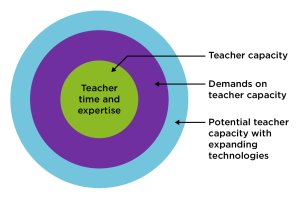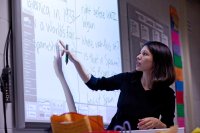How Edtech Can Expand What Teachers Do
Education technology has the capacity to increase what a teacher can accomplish in the course of a day’s work.
Your content has been saved!
Go to My Saved Content.Teaching isn’t an easy job, and recent changes in education and society aren’t making it any easier. A generation ago, if you made sure to cover your curriculum according to pacing guides and best practices, you were doing a satisfactory job. But as students’ needs and society’s expectations have risen, so have the demands placed on teachers’ shoulders.
Teachers today need to differentiate their instruction, use data-driven instructional practices, address students’ social and emotional challenges, close achievement gaps, and ensure that all students are prepared for the 21st-century economy. It’s hard to imagine teachers measuring up to these goals just by getting better and working harder.
Fortunately, in the face of these challenges, technology has something to offer. Many common uses of classroom technology serve primarily to enhance teachers’ existing lessons, but technology can start to really move the needle on the many demands on teachers when it expands the frontiers of what they’re able to accomplish in a day.
How Edtech Affects Teaching Practices
You may not have thought about it in those terms before—that edtech assists teachers in basically two ways, by enhancing what they do now, and by expanding what they’re able to do.
First, technology enhances teachers’ current practices by increasing their instructional value or making them work more smoothly. For example, projector slides can enhance your lessons with audiovisual elements such as diagrams, photos, and videos. Sites like Google, Teachers Pay Teachers, and IBM Teacher Advisor can help you enhance your lessons with materials and learning activities that are more engaging, pedagogically sound, or aligned with standards and student needs. Educational YouTube videos can enhance the edutainment in your classroom. Google Classroom can enhance your workflow by helping you bypass the copy room.
These technologies don’t fundamentally change the way you teach, but they can enhance your current practices by improving their instructional value or making them work more efficiently for you and for your students.
Second, technology can expand teachers’ capacity to implement new practices that would otherwise be challenging to adopt and maintain. Human history is in part a story of new technologies that make new practices possible. From the wheel to the steam engine to the supercomputer, these technologies expand how people produce the goods of life. Food, clothing, housing, energy, and entertainment are all far more affordable and accessible than they were just a few generations ago because technology has steadily pushed out the frontier of human productivity.
Technology can play a similar role for teachers by helping them use their time, attention, and energy in new ways to make a bigger difference for their students. For example, online learning technologies like Lexia Core5 Reading and Newsela can adapt instruction to students’ individual learning needs, thereby expanding teachers’ capacity to offer differentiated learning. Adaptive software platforms can give teachers daily snapshots of students’ learning progress, thereby making data-driven instruction much more manageable. And writing feedback software such as Ecree and NoRedInk can provide automated feedback on the grammar and structure of students’ essays so that teachers can focus their feedback on higher-order elements of writing that often get shortchanged, such as reasoning, rhetoric, and style.
In many blended learning instructional models, teachers create online videos to replace their lectures so that students can learn the foundational content for each unit in an independent, self-paced, mastery-based manner. With this shift, the teachers can spend more of their class time working directly with students. Many teachers also find that reallocating class time through blended learning expands their capacity for a host of other valuable learning activities—such as problem-based learning, project-based learning, or small group instruction—and creates more time for personal interactions that foster caring and supportive relationships.
These valuable teaching practices—differentiated instruction, data-driven instruction, higher-order feedback, mastery-based instruction, problem-based learning, project-based learning, small-group instruction, and relationship-building—predate most educational technologies. They don’t require technology, but technology can expand teachers’ capacity to adopt these practices in a manageable way.
The diagram below illustrates the power of technology to expand teachers’ capacity for new practices, increasing what teachers are able to accomplish with their students given the fixed amounts of time and energy they have in a given day.

Enhancing and expanding can both be worthwhile ways to use edtech. Yet for perfectly understandable reasons, expanding is often the road less traveled. If you’re a busy teacher, when do you find the time to sift through the overwhelming amount of edtech on the market and then learn a bunch of new practices? And given how tech can come and go, it’s reasonable to be leery of investing your time in tools that might not last. Furthermore, when you’ve spent years developing and honing your current practices, it may seem like it doesn’t make sense to set them aside and try radically different approaches to teaching. When you have a system that already works for you, the work involved in adopting new practices rarely seems worth the cost. But many teachers are indeed working to expand their practices by trying those radical new approaches.
Is changing how you teach easy? No. But for many teachers who are using technology to expand their teaching repertoire, looking back isn’t an option. This change takes a lot of work, but ultimately it lets teachers have more of the types of experiences with students that made them want to become teachers in the first place.
